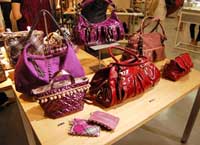Web Japan > Trends in Japan > Fashion > Berry-Tinted Winter
Berry-Tinted Winter
Fruity Colors Dominate the Season's Fashions
The streets of Japan's major cities this winter are filled with colors that conjure up images of blueberries, raspberries, cranberries, and other purple- and red-hued fruits. In addition to brighter tones like violet and magenta, people are also showing a preference for burgundy and other deeper shades. Purple has emerged as the color of choice for knit tops and blouses, as well as for dresses, skirts, coats, handbags, shawls, boots, and even accessories, such as necklaces and corsages.
New Base Color
Traditionally, people have opted for black, gray, and navy as the base colors for their fall-winter wear. They have been adding olive, khaki, and other subdued tones in recent years, due partly to the popularity of the military look. This year, though, the overwhelming favorite seems to be berry purple. These hues have been used not just for things people wear but also for many storefront displays.
Shades of purple have long been popular, but until now they have been used mostly as an accent, such as for belts and undergarments. This year, though, berry tints are being used in bolder, more noticeable ways and are fast emerging as a basic, indispensable color for the fashion-conscious.
Timeless Favorite
Berry purple began gaining prominence around two years ago, as teenage girls in neighborhoods like Harajuku and Shibuya began sporting bright purple insulated jackets. This appeared to be a reaction against the darker hues that had been common until then. Today, purple is being worn by women in their twenties and thirties, and it has become a popular color for men's scarves and neckties as well. Purple is this season's top trendsetter.
Berry colors are showing up not just in fashion but also in recent models of products like mobile phones and digital cameras, as well as in the packaging for hair-care items. Names created for the color of such products include "live pink," "gradation purple," and "berry pink."
Purple has traditionally been regarded as a noble color in Japan. In the seventh century, a system of court rank based on personal competency and distinguished service was established by Prince Shotoku. The system designated different colored crowns for individuals and is believed to have assigned deep purple to those in the highest rank.
Berry hues can enhance complexion and give the appearance of fairer skin tones. This may be another reason that many Japanese people have developed a preference for these colors. (February 2009)



